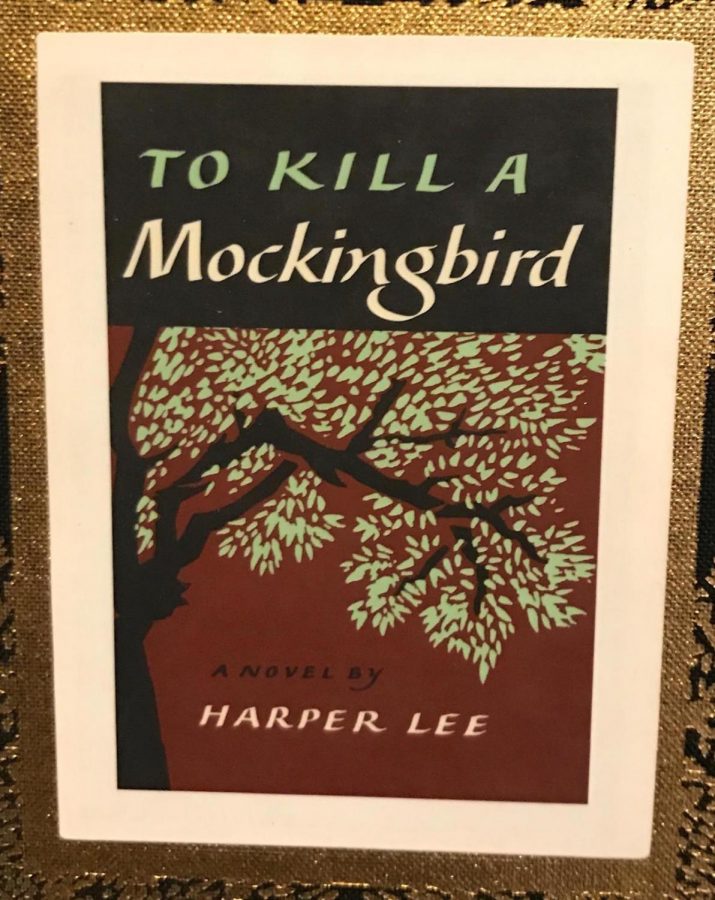Great Literature Can Still Ruffle Feathers
In light of the recent news that one school district removed Harper Lee’s classic To Kill a Mockingbird from its curriculum, the Red & Black discusses censorship and true lessons literature offers to readers.
Photo by Michele Sullivan
To Kill a Mockingbird by Harper Lee
From Scout’s ham costume to emotional trial of Tom Robinson, there are many reasons why every American should read Harper Lee’s To Kill a Mockingbird. Published in 1960, the novel takes place in the little town of Maycomb, Alabama during the Great Depression. The story revolves around a little girl named Jean Louise Finch or “Scout,” her brother Jem Finch, and their father Atticus Finch. In summary, it’s a coming of age story that explores the issues of race, class, and coming of age through the depiction Atticus’ court case, where Tom Robinson, a black man, was falsely charged with raping Mayella Violet Ewell, a white woman. Aspects of Lee’s story came from her own upbringing in a deep southern town in Alabama.
Since the novel was first published, it has never been out of print. Most American high schools have To Kill a Mockingbird included in their English curriculum. In Patchogue-Medford School District, ninth graders are expected to read the novel in their first high school level English classes.
In fact, according to The Guardian, To Kill A Mockingbird was ranked higher than the Bible in terms of most influential books. The Bible has been printed over five million copies versus To Kill a Mockingbird’s forty million prints. Many generations have read the novel and many people are reading it today.
While there’s no arguing over the level of influence the novel has, in fact, The Guardian named ranked it as No. 78 on its list of most influential books of all time, some schools and libraries feel as if the story is too strong for young readers. Biloxi School District, from Mississippi, is currently receiving backlash for their decision to pull the book from its eighth grade English Language Arts curriculum this month. Kenny Holloway, vice president of the Biloxi School Board, explained that they had received complaints about the book and its language. The book apparently made students and parents feel uncomfortable.
This, of course, is nothing new. This isn’t the first time To Kill a Mockingbird has been pulled off of the shelf or from a curriculum, and it isn’t the first time that the novel has made people feel uncomfortable. It most likely won’t be the last time either. The use of the N-word, the portrayal of a small, closed-minded southern town, and the topic of rape can all provoke feelings of discomfort in some readers. Students are most likely going to feel uncomfortable when they read the N-word in dialogues, and even more uncomfortable when they have to read passages aloud.
Shying away from reading such an important novel because it makes a student uncomfortable is hardly a solution. Mrs. Scaldaferri, an English teacher at Patchogue-Medford High School who formerly taught ninth grade English honors, expressed that, “Even though To Kill a Mockingbird may touch upon subjects like racism that may be uncomfortable for some people to confront, it’s still an important work of literature because ignoring issues won’t make them go away.” In history, the topic of racism, slavery, and equality was always pushed for a later date, but like Mrs. Scaldaferri expressed, the people of our country, in every century, soon realize that those problems never disappear. “The climate of our country today and all the issues regarding race, equality, and racism that are now coming to light,” she added, “It’s more important than ever to have students confront those ideas and teach them how to deal with topics like these in their everyday lives.” Students need to learn how to face these topics for both their own benefit and their community’s benefit.
If students are sheltered from the topics of racism, they won’t know how to challenge the issue in their own lives. Even Atticus Finch agreed that sheltering kids from these issues isn’t efficient when he told Jem, “There’s a lot of ugly things in this world, son. I wish I could keep ’em all away from you. That’s never possible.” Keeping students away from these issues won’t make them go away; it’ll only make these issues more prominent. Mrs. Lewis, a current ninth grade English teacher, stated, “I think kids shouldn’t be sheltered behind these topics. Once they get into the book, they learn to be sympathetic towards the characters. Harper Lee touches upon these issues with such grace that I think kids really understand the lesson being told.” When students have the opportunity to read To Kill a Mockingbird, it influences them to think about racism they’ve encountered in their own lives and events that are happening in the world today.
The banning of To Kill a Mockingbird implies that it’s okay to avoid issues like racism. After all, the founding fathers of the United States pushed away the idea of freeing the slaves and considering them as citizens when creating the Constitution. It took our country almost eighty years to even consider granting slaves emancipation and citizenship. It took our country another whole century after that to finally end segregation. And now, more than half a century later, we still face issues that look to racism as its core. Whether it’s about the pay gap, police brutality, supporting the Black Lives Matter movement, or protests against confederate symbols, people need to understand that racism is not a thing of the past. As Atticus once said, “Simply because we were licked a hundred years before we started is no reason for us not to try to win.” Just because our history has a long past of pushing this issue away, it doesn’t mean that we have to accept it as just history.
The school district is also receiving backlash for displaying the Mississippi state flag. While it’s not controversial for a high school to fly their state flag, the Mississippi state flag depicts the Confederate symbol, and this only fuels the idea that the school district is complicit with issues regarding race.
For some people, it’s unbelievable that a school could pull such an influential book out from its curriculum because it makes people uncomfortable. Mrs. Gloria Sesso, Patchogue-Medford School District’s Director of Secondary Humanities, 6-12 ELA and Social Studies, voiced, “It is hard to see why people would feel uncomfortable with a story about courage and justice. I have read and used excerpts of the story in classes about equal rights and the United States legal system.” Mrs. Sesso only demonstrates further how influential the novel is when mentioning her usage of excerpts in classes she’s taught throughout her career.
While some students claimed that the language made the story uncomfortable for them, most students understand the significance of the novel. Sarah Varghese, a current tenth grader who read the book just last year, stated, “I really enjoyed the book, it’s great. It teaches students morals. The topics aren’t sugar-coated and I think that’s important. These issues are raw.” Elizabeth Niemiec, another tenth grader at Patchogue-Medford High School, added, “The book was written to make people feel uncomfortable about the racial division in the country. We need to expose students to that, and we can’t remove the book from curriculums. Students are mature enough to read about the issues that Harper Lee touches upon.”
Again, sheltering students from these issues will only hurt them in the future. The novel teaches readers to be sympathetic towards the characters and the theme of loss of innocence. Even Atticus knows that, “you never really understand a person until you consider things from his point of view… Until you climb inside of his skin and walk around in it.”

Adelphi Quill Award Winner - 3rd Place, Most Outstanding Reporter (2018)
Grade 12
"You can never be overdressed or overeducated." - Oscar Wilde






